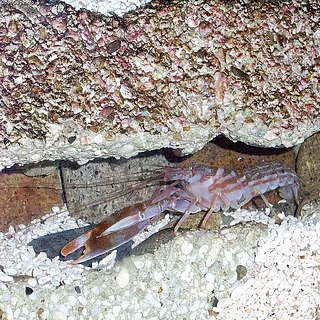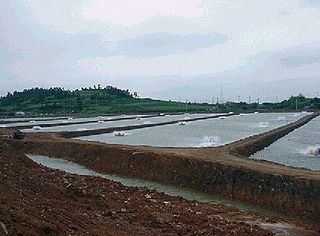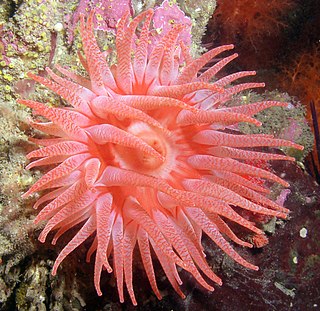
The Caridea, commonly known as caridean shrimp or true shrimp, from the Greek word καρίς, καρίδος, are an infraorder of shrimp within the order Decapoda. This infraorder contains all species of true shrimp. They are found widely around the world in both fresh and salt water. Many other animals with similar names – such as the mud shrimp of Axiidea and the boxer shrimp of Stenopodidea – are not true shrimp, but many have evolved features similar to true shrimp.

Dendrobranchiata is a suborder of decapods, commonly known as prawns. There are 540 extant species in seven families, and a fossil record extending back to the Devonian. They differ from related animals, such as Caridea and Stenopodidea, by the branching form of the gills and by the fact that they do not brood their eggs, but release them directly into the water. They may reach a length of over 330 millimetres (13 in) and a mass of 450 grams (1.0 lb), and are widely fished and farmed for human consumption.

Mantis shrimp are carnivorous marine crustaceans of the order Stomatopoda. Stomatopods branched off from other members of the class Malacostraca around 340 million years ago. Mantis shrimp typically grow to around 10 cm (3.9 in) in length, while a few can reach up to 38 cm (15 in). A mantis shrimp's carapace covers only the rear part of the head and the first four segments of the thorax. Varieties range in colour from shades of brown to vivid colours, with more than 520 species of mantis shrimp known. They are among the most important predators in many shallow, tropical and subtropical marine habitats. However, despite being common, they are poorly understood, as many species spend most of their lives sheltering in burrows and holes.

Clam shrimp are a group of bivalved branchiopod crustaceans that resemble the unrelated bivalved molluscs. They are extant and also known from the fossil record, from at least the Devonian period and perhaps before. They were originally classified in the former order Conchostraca, which later proved to be paraphyletic, due to the fact that water fleas are nested within clam shrimps. Clam shrimp are now divided into three orders, Cyclestherida, Laevicaudata, and Spinicaudata, in addition to the fossil family Leaiidae.

Adrian Hardy Haworth was an English entomologist, botanist and carcinologist.

Alpheidae is a family of caridean snapping shrimp, characterized by having asymmetrical claws, the larger of which is typically capable of producing a loud snapping sound. Other common names for animals in the group are pistol shrimp or alpheid shrimp.

Marine shrimp farming is an aquaculture business for the cultivation of marine shrimp or prawns for human consumption. Although traditional shrimp farming has been carried out in Asia for centuries, large-scale commercial shrimp farming began in the 1970s, and production grew steeply, particularly to match the market demands of the United States, Japan and Western Europe. The total global production of farmed shrimp reached more than 1.6 million tonnes in 2003, representing a value of nearly 9 billion U.S. dollars. About 75% of farmed shrimp is produced in Asia, in particular in China and Thailand. The other 25% is produced mainly in Latin America, where Brazil, Ecuador, and Mexico are the largest producers. The largest exporting nation is India.
White spot syndrome (WSS) is a viral infection of penaeid shrimp. The disease is highly lethal and contagious, killing shrimp quickly. Outbreaks of this disease have wiped out the entire populations of many shrimp farms within a few days, in places throughout the world.

Axiidea is an infraorder of decapod crustaceans. They are colloquially known as mud shrimp, ghost shrimp, or burrowing shrimp; however, these decapods are only distantly related to true shrimp. Axiidea and Gebiidea are divergent infraoders of the former infraorder Thalassinidea. These infraorders have converged ecologically and morphologically as burrowing forms. Based on molecular evidence as of 2009, it is now widely believed that these two infraorders represent two distinct lineages separate from one another. Since this is a recent change, much of the literature and research surrounding these infraorders still refers to the Axiidea and Gebiidea in combination as "thalassinidean" for the sake of clarity and reference. This division based on molecular evidence is consistent with the groupings proposed by Robert Gurney in 1938 based on larval developmental stages.

Cleaner shrimp is a common name for a number of swimming decapod crustaceans that clean other organisms of parasites. Most are found in the families Hippolytidae and Palaemonidae, though the families Alpheidae, Pandalidae, and Stenopodidae each contain at least one species of cleaner shrimp. The term "cleaner shrimp" is sometimes used more specifically for the family Hippolytidae and the genus Lysmata.

The Japanese water shrew, also called the flat-headed water shrew, is a species of mammal in the family Soricidae. It is endemic to Japanese Islands, Honshu and Kyushu. They are considered extinct in Shikoku.

Cribrinopsis fernaldi, also known as the crimson anemone, snakelock anemone, chevron-tentacle anemone and Fernald brooding anemone, is a sea anemone native to the Pacific Ocean off northwestern North America.

Ancylomenes magnificus, also known as the magnificent anemone shrimp, is a species of cleaner shrimp common to the Western Pacific Ocean at depths of 3–29 metres (10–95 ft). They are commonly found on stony coral, Catalaphyllia and the sea anemone, Dofleinia armata.

Heterocarpus ensifer is a species of deep-water shrimp. The nominate subspecies is found in the Atlantic Ocean from Spain and Madeira to Angola and from North Carolina to the Gulf of Mexico and Caribbean Sea; other subspecies occur in the Pacific Ocean and around the Philippines and Indonesia. Despite being one of the most abundant shrimp in some areas, its biology is still poorly known. These deep water crustaceans are most copious between 300 and 400m. Their distribution demonstrates an ability to adapt well to distinct environments. It is generally found at depths of 200–885 m (656–2,904 ft).

Heterocarpus is a genus of deep-sea shrimp, mainly of tropical areas all over the world.

Pandalus montagui is a species of cold-water shrimp in the family Pandalidae. It is the type species of the genus Pandalus and is variously known as the pink shrimp, Aesop shrimp and Aesop prawn.

A shrimp is a crustacean with an elongated body and a primarily swimming mode of locomotion – typically belonging to the Caridea or Dendrobranchiata of the decapod order, although some crustaceans outside of this order are also referred to as "shrimp".

Prawn is a common name for small aquatic crustaceans with an exoskeleton and ten legs, some of which are edible.

Pandalus hypsinotus is a crustacean in the Pandalidae family, ordinarily 10–12.5 centimetres (3.9–4.9 in) in length, but large females may reach 17.5 centimetres (6.9 in). It can be found in the Bering Sea, from the Aleutian Islands to Puget Sound, and in the Sea of Japan at depths of 100–200 metres (330–660 ft).

Pandalus lucidirimicola, the sparkling shrimp, is a species of caridean shrimp in the family Pandalidae.

















